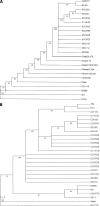Genes related to long polar fimbriae of pathogenic Escherichia coli strains as reliable markers to identify virulent isolates
- PMID: 19494071
- PMCID: PMC2725649
- DOI: 10.1128/JCM.00566-09
Genes related to long polar fimbriae of pathogenic Escherichia coli strains as reliable markers to identify virulent isolates
Abstract
Lpf (stands for long polar fimbriae) is one of the few adhesive factors of enterohemorrhagic Escherichia coli O157:H7 associated with colonization of the intestine. E. coli O157:H7 strains possess two lpf loci encoding highly regulated fimbrial structures. Database analysis of the genes encoding the major fimbrial subunits demonstrated that they are present in commensal as well as pathogenic (both intestinal and extraintestinal) E. coli strains and in Salmonella strains and that the lpfA1 and lpfA2 genes are highly prevalent among LEE (locus of enterocyte effacement)-positive E. coli strains associated with severe and/or epidemic disease. Further DNA sequence analysis of the lpfA1 and lpfA2 genes from different attaching-and-effacing E. coli strains has led us to the identification of several polymorphisms and the classification of the major fimbrial subunits into distinct variants. Using collections of pathogenic E. coli isolates from Europe and Latin America, we demonstrated that the different lpfA types are associated with the presence of specific intimin (eae) adhesin variants and, most importantly, that they are found in specific E. coli pathotypes. Our results showed that the use of these fimbrial genes as markers, in combination with the different intimin types, resulted in a specific test for the identification of E. coli O157:H7, distinguishing it from other pathogenic E. coli strains.
Figures

References
-
- Blanco, M., J. E. Blanco, A. Mora, G. Dahbi, M. P. Alonso, E. A. González, M. I. Bernárdez, and J. Blanco. 2004. Serotypes, virulence genes, and intimin types of Shiga toxin (verotoxin)-producing Escherichia coli isolates from cattle in Spain and identification of a new intimin variant gene (eae-xi). J. Clin. Microbiol. 42645-651. - PMC - PubMed
-
- Blanco, M., S. Schumacher, T. Tasara, C. Zweifel, J. E. Blanco, G. Dahbi, J. Blanco, and R. Stephan. 2005. Serotypes, intimin variants and other virulence factors of eae positive Escherichia coli strains isolated from healthy cattle in Switzerland. Identification of a new intimin variant gene (eae-η2). BMC Microbiol. 523. - PMC - PubMed
Publication types
MeSH terms
Substances
Associated data
- Actions
- Actions
- Actions
- Actions
- Actions
- Actions
- Actions
- Actions
- Actions
- Actions
- Actions
- Actions
- Actions
- Actions
- Actions
- Actions
- Actions
- Actions
- Actions
- Actions
- Actions
- Actions
- Actions
- Actions
- Actions
- Actions
- Actions
- Actions
- Actions
- Actions
- Actions
- Actions
- Actions
- Actions
- Actions
- Actions
- Actions
- Actions
- Actions
- Actions
- Actions
- Actions
- Actions
- Actions
- Actions
- Actions
- Actions
- Actions
- Actions
- Actions
Grants and funding
LinkOut - more resources
Full Text Sources
Other Literature Sources

